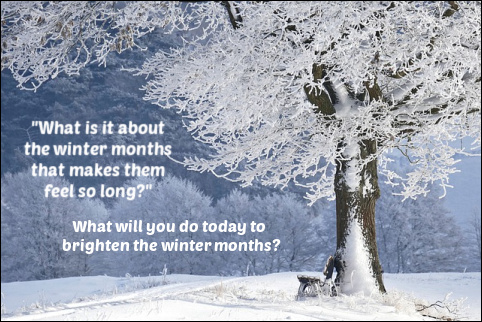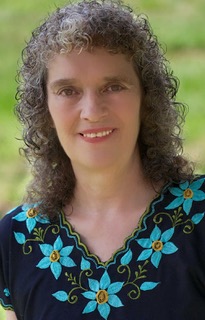Overcome the Longest Season
Susan K. Stewart has expertise in many areas, and in this Health UPGRADE, she deals with the problem of the "long season" of January 1st until Easter and how it affects so many of us.
 “New Year’s Day to Easter is the longest part of the year," Susan says. "It doesn’t matter if Easter is early in March or late in April—it’s long.”
“New Year’s Day to Easter is the longest part of the year," Susan says. "It doesn’t matter if Easter is early in March or late in April—it’s long.”
I (Dawn) don't think San Diegans are bothered much by the "long season," but I remember how I felt when I lived back in the Midwest. I remember being a bit depressed every February. Susan explains why that probably happened.
Susan continues . . .
Those were words of wisdom from my credential advisor in college, Dr. Anne Mitchell. Her other pearl was, “Don’t smile until Thanksgiving.”
Dr. Mitchell not only had experience teaching college, but also teaching elementary school. She knew about the ups and downs of classrooms from the front. Truth be told, though, I did catch her smiling once before Thanksgiving.
No matter the educational setting; I’ve found Dr. Mitchell’s maxims to be true. I didn’t understand the comment about the first months of a calendar year until I experienced it in a classroom. Later in our homeschool, the same phenomena held.
Those winter days dragged.
I tried impromptu snowball fights, backwards day, and let’s skip math day. Although these special, often unannounced times were fun in the moment, none relieved the day-to-day SLOG toward spring.
We know the seasons are ever-changing: spring to summer, summer to fall, fall to winter, winter to spring. God tells us in Genesis 8:22, “While the earth remains, seedtime and harvest, cold and heat, summer and winter, day and night, shall not cease.”
We know the dark days of winter will pass.
A couple of years into homeschooling, I started doing away with the classroom model of teaching. It wasn’t working for our family.
When our school schedule started to revolve more around our family schedule, I found ways to avoid the dragging winter days.
What is it about the winter months that makes them feel so long?
First, although the days are getting longer, they are still dark with clouds, fog, and storms. Even southern areas are darker.
Second, the dark and stormy days mean less sunshine.
God’s creativity is beyond our comprehension. When he created the sun, He provided more than light. He provided what is needed for plants to grow and humans to exist.
Our bodies respond positively to sunlight. Sunlight releases the “feel good” hormone serotonin in the brain.
Conversely, darkness release melatonin, which helps us sleep. Less sunshine, less feel-good juice running through our brains.
Third, we are not as physically active in the winter.
Even in southern states, the days are cold—too cold to be outside. Because we’re indoors, we sit.
Fourth, our sleep cycles can be disrupted.
As the sun goes down our bodies want to produce our sleep juice, melatonin. Instead, we turn on more lights. Our brain doesn’t know what to do, so it either stays awake or it tries to compensate with increased melatonin.
This increase can cause us to be sluggish during the day.
Finally, a result of being indoors is more screen time.
Even though we try to maintain a regular schedule for school, we aren’t coming and going as much. The substitute has become video games or “educational” programming.
Knowing what causes the long time between New Year and Easter helps us to take steps to brighten the days.
How to Overcome the Longest Season
1. Go Ahead and Get Outside.
Unless there’s a dangerous storm or below freezing temperatures, go outside a few minutes every day.
The clouds don’t stop all of the sun rays from getting through.
Some UV rays filter through the clouds allowing us to absorb some. Even though these beneficial rays are absorbed through the skin, even a few minutes on our faces is beneficial.
Watch the time outside as closely as in the summer. Although sunburn may not be a risk, frostbite could.
In areas where the temperatures can be below freezing, open the curtains wide. Allow as much light to come in as possible. Some families also find light therapy helpful as well. Special lamps can be set up to mimic the rays from the sun.
2. Move, Move, Move.
Let the little ones run in the house. Ask older kids to make up some exercises the whole family can do. Plan at least thirty minutes of movement three times a day.
Exercise not only helps release the endorphins to feel better, but the exercise is also good for heart and muscles. Some local gyms have programs for families to exercise together.
Help your homeschool group plan indoor park days with physical activity. Even walking around a museum or shopping mall is better than sitting.
3. Monitor Screen Time—Set Limits.
With online classes, our children are spending several hours each day in front of a screen.
Afterschool activities can include board games, puzzles, and round robin reading. A rousing game of charades is delightful for little ones as well as adults.
If you don’t want to totally turn off computers or TV, set a time limit. Do the same for yourself.
4. Lower Lights in the House as the Evening Comes On.
This will help maintain our natural sleep cycles. Turn off screens at least an hour before bedtime (those are sources of light as well).
Spend time recapping the day, reading a bedtime story, and enjoying bath time rather than rushing to get everyone in bed on time.
Bedtime is a good time to recall God’s word and recite Bible verses.
5. Be Flexible.
Maybe everyone needs to sleep a little longer in the morning.
Unless your child is in a school program that requires online time each day, go ahead and skip regular schooldays.
If one of the kids is struggling with a subject, set it aside for a couple weeks. It’s hard enough during the brighter days of spring, doubly hard when all of us have the winter humdrums.
Don’t slog your way through the long season at the beginning of the new year. Prepare for it, embrace it, and enjoy it.
What will you do today to brighten the winter months?
 Susan K. Stewart, Nonfiction Managing Editor with Elk Lake Publishing Inc., teaches, writes, and edits nonfiction. Susan’s passion is to inspire readers
Susan K. Stewart, Nonfiction Managing Editor with Elk Lake Publishing Inc., teaches, writes, and edits nonfiction. Susan’s passion is to inspire readers  with practical, real-world solutions. Her books include Science in the Kitchen, Preschool: At What Cost?, Harried Homeschoolers Handbook, and the award-winning Formatting e-Books for Writers. Her latest book, Donkey Devos: Listening when God speaks, is scheduled to be released spring 2021. You can learn more at her website www.practicalinspirations.com.
with practical, real-world solutions. Her books include Science in the Kitchen, Preschool: At What Cost?, Harried Homeschoolers Handbook, and the award-winning Formatting e-Books for Writers. Her latest book, Donkey Devos: Listening when God speaks, is scheduled to be released spring 2021. You can learn more at her website www.practicalinspirations.com.
Graphic adapted, courtesy of gamagapix at Pixabay.
 1 Comment → Posted on
1 Comment → Posted on  Thursday, January 14, 2021 at 10:12AM
Thursday, January 14, 2021 at 10:12AM  Darkness of Winter,
Darkness of Winter,  Homeschooling,
Homeschooling,  Less sunshine,
Less sunshine,  Longest Season,
Longest Season,  Sleep Cycles in Winter,
Sleep Cycles in Winter,  Susan K. Stewart,
Susan K. Stewart,  Upgrade with Dawn,
Upgrade with Dawn,  Winter Upgrade Your Life
Winter Upgrade Your Life  Health
Health 




Reader Comments (1)
Thanks for this post Susan. It's pretty easy to get stuck in a rut, But God knows just how to pick us up every morning.